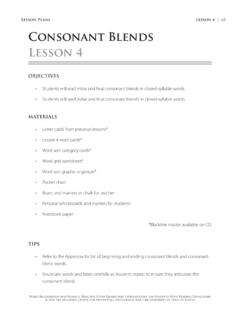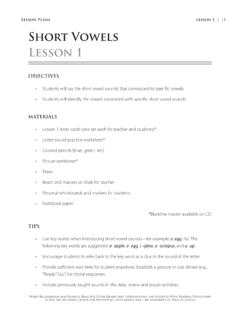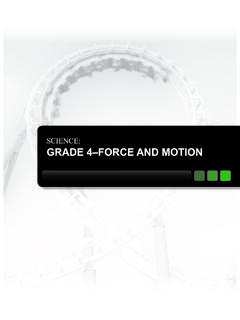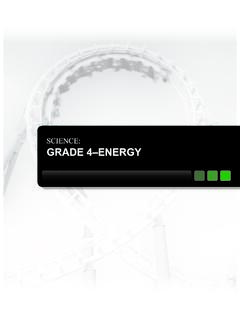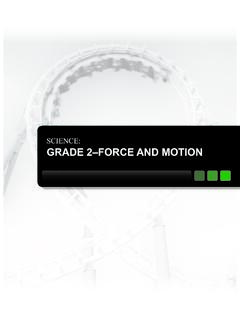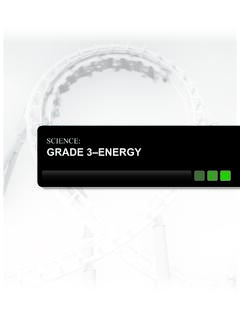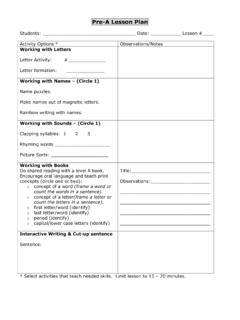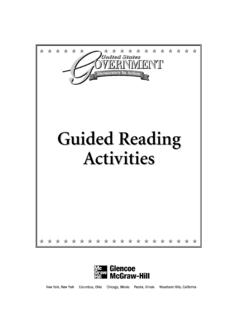Transcription of Lesson Plans Lesson 3 | Consonant Digraphs Lesson 3
1 Word Recognition and Fluency: Effective Upper-Elementary Interventions for Students With reading Difficulties 2010 The Meadows Center for Preventing Educational Risk, the University of Texas at AustinLesson Plans Lesson 3 | 43 Word Recognition and Fluency: Effective Upper-Elementary Interventions for Students With reading Difficulties 2010 The Meadows Center for Preventing Educational Risk, the University of Texas at AustinConsonant DigraphsLesson 3 OBJECTIVES tudents will read and spell initial and final Consonant Digraphs in closed-syllable Lesson 1 letter cards* Lesson 3 letter cards* Lesson 3 word cards* Sentence reading worksheet* Cloze sentences worksheet* Pocket chart Board and markers or chalk for teacher Personal whiteboards and markers for students Notebook paper*Blackline master available on Refer to the Appendix for a list of Consonant digraph words.
2 A student should master one digraph before progressing to another. Depending on your students, introduce multiple Digraphs during a single Lesson . Include examples and nonexamples of words containing Digraphs . Decode and encode, using real words and nonsense words. 44 | Lesson 3 Lesson PlansWord Recognition and Fluency: Effective Upper-Elementary Interventions for Students With reading Difficulties 2010 The Meadows Center for Preventing Educational Risk, the University of Texas at AustinWord Recognition and Fluency: Effective Upper-Elementary Interventions for Students With reading Difficulties 2010 The Meadows Center for Preventing Educational Risk, the University of Texas at AustinDAILY REVIEW VOWELS, CVC WORDSR eview vowel sounds and CVC words. For vowels, students should say the letter name, key word, and sound.
3 Review blending and segmenting CVC words, and review that each letter makes its own sound. Ask for individual and group responses, and keep a brisk pace. Teacher: Let s start by quickly reviewing vowels. I will point to a letter, and you will tell me the name of the letter, its key word, and its sound. For example, if I point to e, your response is, e, egg, /e/. Be alert, because I will go quickly! Remember that the cue I give when it s time for you to repeat is an open palm, like this.[Gesture. Then, point to i and gesture.]Students: i, itch, /i/.Teacher: Excellent![Continue reviewing all short vowel sounds.] Let s review blending CVC words. Remember that each letter makes its own sound. [Write bat on the board. Say the sounds as you slide your finger under each letter.]Teacher: /b/ /a/ /t/, bat. Complete a quick review of CVC words by having students read word : In the words we just reviewed, each letter made its own sound.
4 /b/ /a/ /t/ three letters, three sounds. Today, we will learn about Digraphs . A digraph is two consonants that combine to make one sound. Most of the time, that sound is different from the sound that each letter makes individually. Digraphs are important to learn because if you did not know that the two letters in a digraph make one sound, you would be unable to read many new Recognition and Fluency: Effective Upper-Elementary Interventions for Students With reading Difficulties 2010 The Meadows Center for Preventing Educational Risk, the University of Texas at AustinLesson Plans Lesson 3 | 45 Word Recognition and Fluency: Effective Upper-Elementary Interventions for Students With reading Difficulties 2010 The Meadows Center for Preventing Educational Risk, the University of Texas at AustinMODEL AND TEACH: ACTIVITY 1 INTRODUCE DIGRAPHSDECODINGI ntroduce one digraph, such as sh, by reviewing each letter s sound separately.
5 Teach students that when these letters appear together, they make one sound. Point out that Digraphs can appear at the beginning or end of a : We just reviewed that s says /s/ and h says /h/. [Write s and h next to each other.] Teacher: When s and h are together in a word, they make a new sound: /sh/. What sound does sh make?Students: /sh/Teacher: We ll use shop as the key word for /sh/. sh, shop, /sh/. Repeat : sh, shop, /sh/.[Write o and p after sh to form shop. Circle sh.]Teacher: /sh/ can appear at the beginning of a word, like we just learned with shop. [Write cash, circling sh.]Teacher: It can also come at the end of a word, as in cash. What sound does sh make?Students: /sh/After teaching the digraph, use letter cards to model blending /sh/ with other sounds to make words. Point to the letters as you blend the sounds.
6 When counting the number of sounds in a word, a digraph counts as only one sound. Repeat the sequence with other words, gradually reducing your modeling to give students greater independence. [Display sh, o, and p in a pocket chart or on the table, leaving some space between the letters.] Teacher: You blend Digraphs with other sounds to make words, as we did with CVC | Lesson 3 Lesson PlansWord Recognition and Fluency: Effective Upper-Elementary Interventions for Students With reading Difficulties 2010 The Meadows Center for Preventing Educational Risk, the University of Texas at AustinWord Recognition and Fluency: Effective Upper-Elementary Interventions for Students With reading Difficulties 2010 The Meadows Center for Preventing Educational Risk, the University of Texas at Austin[Point to sh and say /sh/.]
7 Point to o and say /o/. Then, slide your finger under each sound as you blend them.] /sh/ /o/; your turn. Blend the sounds as I slide my finger under the letters. Students: /sh/ /o/[Model adding the final /p/: Slide your finger under sh and o, stretching out the sounds until you point to p.]Teacher: /sh/ /o/ /p/; your : /sh/ /o/ /p/ [Move the cards next to each other. Slide your finger under the letters.]Teacher: Shop the whole word is shop. Now, I will slide my finger under the letters, and you will read the word. Students: shopTeacher: Although there are four letters, there are just three sounds because s and h make one sound, /sh/. [Model counting with your fingers: /sh/, /o/, /p/.]Repeat the sequence with new words, gradually reducing your modeling. ERROR CORRECTIONIf a student makes an error with a digraph sound, guide the student by using questions about the key word.
8 If necessary, have the student repeat the blending sequence to read the Introduce new digraph sounds after your students master each sound. The following are suggested key words: th think, ph phone, wh whisper, ck sock, and ch cheer. th can make two different sounds: unvoiced, as in think and Beth, and voiced, as in the and that. Teach students that the unvoiced /th/ feels like air over the tongue and that making the voiced /th/ causes the tongue to vibrate. Word Recognition and Fluency: Effective Upper-Elementary Interventions for Students With reading Difficulties 2010 The Meadows Center for Preventing Educational Risk, the University of Texas at AustinLesson Plans Lesson 3 | 47 Word Recognition and Fluency: Effective Upper-Elementary Interventions for Students With reading Difficulties 2010 The Meadows Center for Preventing Educational Risk, the University of Texas at AustinMODEL AND TEACH: ACTIVITY 2 SEGMENTING SOUNDSENCODINGHave students encode words containing Digraphs by using the following sequence:1.
9 Dictate a A student repeats the word (listen for correctness).3. The student says each sound in the word and counts the sounds in the The student says the letters that represent the The student again says the letters while collecting the corresponding letter The student checks by reading the the sequence with new words, gradually decreasing your : The first word is rush. What is the word? Students: rushTeacher: Next, I will count the sounds I hear in the word. [Model the following steps as you complete them.] /r/ /u/ /sh/. I hear three sounds. Next, I think about what letters make those sounds. /r/ r, /u/ u, /sh/ sh. Now, I say the letters while I get the letter cards: r, u, s, h. Finally, I check the word by reading it: the sequence with new words, gradually decreasing your Tell students that the digraph ck is never at the beginning of a word.
10 /k/ at the beginning of a word is usually spelled c or, less often, k. Tell students that the digraph wh is never the final letters of a word. 48 | Lesson 3 Lesson PlansWord Recognition and Fluency: Effective Upper-Elementary Interventions for Students With reading Difficulties 2010 The Meadows Center for Preventing Educational Risk, the University of Texas at AustinWord Recognition and Fluency: Effective Upper-Elementary Interventions for Students With reading Difficulties 2010 The Meadows Center for Preventing Educational Risk, the University of Texas at Austin Use blank letter cards (different colors for vowels and consonants) as a visual clue to the structure of words. Have students put the letter cards on top of corresponding blank CORRECTIONIf a student makes an error, say the word and have the student repeat it, emphasizing enunciation.

